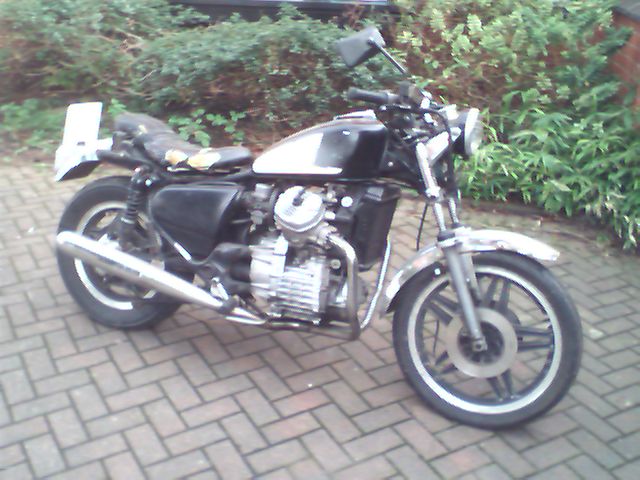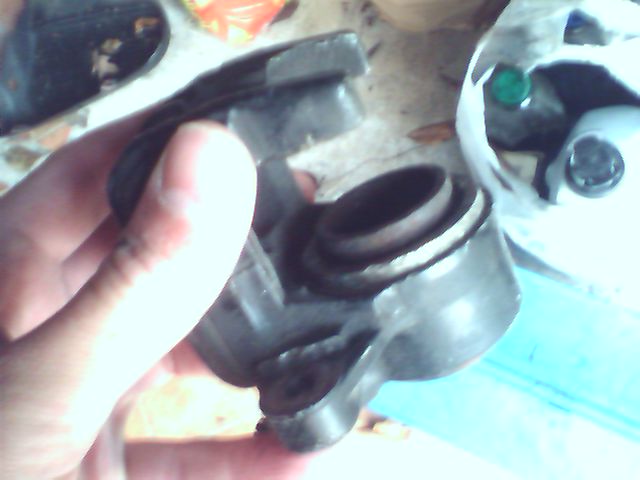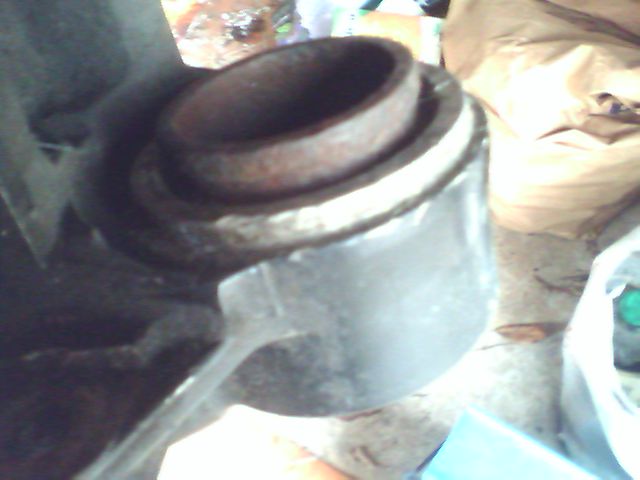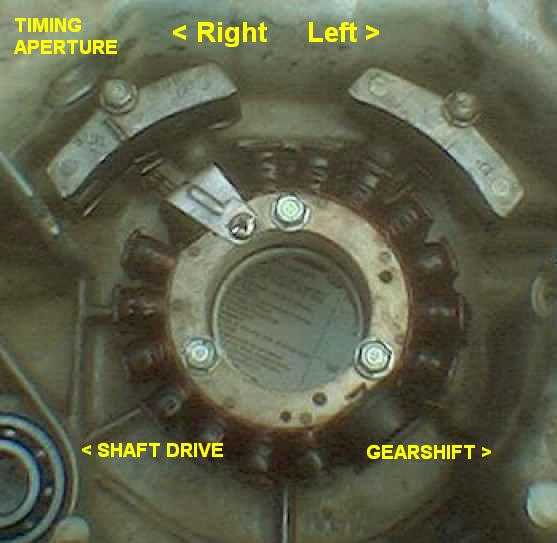A Simple 2D Terrain ModelTank Wars in G3DNasa's Space Shuttle Atlantis Transiting the SunSpooky Case of the Wem GhostGarmin Edge 205 GPS Cycle Training ToolCompiling and Installing Freespace 2 on Ubuntu Linux

compton4:24 pm, Saturday, 26 January 08 |
|
Here's a picture of it as it is now:
 |
|
compton5:24 pm, Saturday, 26 January 08 |
|
The brake pistons are so rusted in that both calipers will need to be replaced:

 |
|
compton10:44 am, Saturday, 8 August 09 |
|
|
The most important issue to sort out is the bike's failure to start. The battery is new and the starter motor seems to be working well as the engine turns over when the starter switch is pressed. Using loads of cold-start spray in the air intake the engine will fire briefly, but splutter and die out once the cold-start vapour is all burnt up (I presume that's what's happening) The pre 1982 CX500s are sort of unusual when it comes to the ignition. It could be insufficient fuel getting to the cylinders or possibly a bad air/fuel mixture. The fact that it will fire up when there is loads of highly flammable cold-start mixture involved seems to suggest to me that the problem is mostly to do with the fuel. However the bike has always had this issue, so it could be other things such as bad electrics meaning the spark is not strong enough to ignite without the cold-start stuff. The rectifier converts AC electric from the altenator to DC electric to charge the battery and supply power for lighting. It's not part of the ignition circuit and would not cause such problem. Ignition module (CDI), ignition coils, and ignition pick-up coil are all ignition parts that effect spark. Engine Doesn't Start, Starting DifficultyStarter motor not rotatingStarter lockout or neutral switch troubleStarter motor trouble Battery voltage low Relays not contacting or operating Starter button not contacting Wiring open or shorted Ignition switch trouble Engine stop switch trouble Fuse blown Starter motor rotating but engine doesn't turn overStarter clutch troubleEngine won't turn overValve seizureCylinder, piston seizure Connecting rod small end seizure Connecting rod big end seizure Transmission gear or bearing seizure Camshaft seizure Balancer bearing seizure No fuel flowFuel tap vacuum hose cloggedFuel tank air vent obstructed Fuel tap clogged Fuel line clogged Float valve clogged Engine floodedFuel level in carburetor float bowl too highFloat valve worn or stuck open Starting technique faulty (When flooded, crank the engine with the throttle fully open to allow more air to reach the engine) No spark; spark weakBattery voltage lowSpark plug dirty, broken, or maladjusted Spark plug cap or high tension wiring trouble Spark plug cap not in good contact Spark plug incorrect IC ignitor trouble Neutral, starter lockout, or side stand switch trouble Pickup coil trouble Ignition coil trouble Ignition or engine stop switch shorted Wiring shorted or open Fuse blown Compression low Spark plug loose Cylinder head not sufficiently tightened down Cylinder, piston worn Piston ring bad (worn, weak, broken, or sticking) Piston ring/land clearance excessive Cylinder head gasket damaged Cylinder head warped Valve spring broken or weak Valve not seating properly (valve bent, worn, or carbon accumulation on the seating surface) Hydraulic lash adjuster damaged (worn, seizure, or spring broken) Hydraulic lash adjuster oil passage clogged ~~~~~~~~~~~~~~~~~~~~~~~~~~~~~~~~~~ The &!@^%*#! Thing Won't StartOh boy is this irritating... It's definitely frustrating when you can't get your MC started. The first thing to do is a process of elimination:In order for an engine to start and run, it needs 3 things: 1. Spark at the correct time 2. A proper fuel/air mixture and exhaust flow 3. Sufficient engine compression Sounds easy, right? Cylinder Compression Check: If you just acquired the scooter, you should first do a full inspection before you try to get it running. If this is the case, I'd do a compression check first because it's easy. First check the quantity and condition of the engine oil. Add oil as necessary. I wouldn't change it unless it's terribly dirty. The engine could be bad so you'd waste the oil change. Hook up or purchase a good battery. Leave out the spark plug and crank the scooter for ~5 seconds. This helps to circulate the oil. Let it set for ~15 seconds and do it again. It's not a good idea to continuously crank the starter because it can overheat and wear prematurely. Most scooters need a minimum of 100 psi in compression to run start and properly. Compression should be checked when the engine is warm, but that's kind of hard to do if the scooter is not running. So just hook up a compression gauge and open up the throttle all the way. Crank the scooter until the needle on the compression gauge stops moving. This should take no more than 5 seconds. Very roughly, 100-125 psi is good, 125-150 psi is very good, and 150+ psi is great. If you don't have this level of compression then you have bad valves and/or bad piston rings. If you want, you can add a teaspoon or so of oil to the engine through the spark plug hole. Then try the compression test again. If compression is higher, then it's likely you have bad rings. The oil will seal the rings and give you better compression. If compression is the same, then you have bad/misadjusted valves. Got spark? There are a few ways to check for spark. The easiest way is to remove the spark plug and put it back in the spark plug cap. Then ground it to the engine - you should be able to lay it against a non-painted portion of the engine. Make sure there is good metal-to-metal contact. A darkened area may help to see the arc. You should see a definite spark at the tip of the spark plug. It's hard to see in direct sunlight. If the color of the spark is blue, that means it's a strong spark. A white color is less strong, and a yellow color is weak. Most MC starting systems are a bit weak (compared to cars). Even a yellow spark should start your scooter just fine. Next, the spark must occur at the right time. Just about all scooters made since around 1980 have electronic ignition. These systems rarely can be set. This is good news. After working on maybe 50 MC's, I've never seen one go out of time. Scooters with points are another matter. You'll have to follow the timing procedure in the manual to get the timing correct. In general, the spark occurs just before the piston reaches the top of its stroke. There is a slight delay between the spark plug fire and the fuel-air mixture ignition. That's why the spark occurs a little early. Most ignition systems have an advance unit built in, so that as the engine speeds up the time of the spark retards a little bit and helps the engine fire the mixture at the proper time. Starting Fluid: Assuming sufficient compression, squirt in a bit of starting fluid and see if she'll fire. If so, great! That means that you have sufficient compression and the proper spark. You should get the scooter to run for a second or so on starting fluid. If so there's a good chance you can get it running. One caution here - don't run your engine for long periods on starting fluid because it's hard on the engine. Fuel/Air Mixture: The last thing is the fuel/air mixture. You could be getting too much or too little of either. If the scooter has been sitting for a while, it's likely the gas has evaporated and left a bunch of sludgy deposits. Ask the seller when it last ran. If it's been more than ~3 months, you should clean out the fuel system and the carb. Disconnect the fuel line and drain the old gas. I've been able to burn old gas with no problem by using it in my truck. Add fresh fuel and make sure it flows smoothly through the petcock (on the bottom of the fuel tank). If the petcock is controlled by vacuum, you'll have to draw a vacuum on the vacuum line in order for fuel to flow. The vacuum line will be the smaller line on the petcock. Do you get a good, steady flow of gas? If so good, if not, you will have to remove the petcock and clean it. The gas flow should stop when you release the vacuum. Next, you'll have to remove the carburetor and clean it. There are a lot of tiny fuel and air passageways in the carb that must be clean it order for your scooter to run right. Carefully take the carb apart. This can be relatively easy (on a 50cc scooter) or quite difficult (a Riva 180-200 has limited carb access and 8 separate hoses running to the carb). The carb has tiny passages that get gummed up. The scooter just will not run correctly if the carb is not completely clean, so take your time. I use a gallon container of carb dip (you can get a gallon at your local auto supply store for ~$10). First remove all rubber and gaskets or they will be damaged. After a ~20 minute soaking I blow out the carb with compressed air. You have to get all the jets and the passageways clean. Be sure the jets are clear, especially the starter jet. Sometimes carb cleaner won't clear out these tiny jets. Use a guitar/piano wire, a strand of copper electrical wire, or a tiny drill bit pin vise. Be sure not to increase the size of the hole in the starter jet or you'll change the tuning. Carefully reassemble everything, checking for cracks in the rubber carb boots and the gaskets. Replace them if they are old and cracked. Be sure and remove all rubber and gasket material first or they could get ruined. Carb spray cleaner also works if you're diligent. If you have an electric choke, check it to make sure it works. Check the resistance between the wires - you should see around 10 ohms or less. Measure the length of the choke assembly. Remove the choke from the carb and plug the wires into a 12V source for 15 minutes. The choke body should be warm. Measure the length again - it should increase by around 1/8". Next, consider whether your exhaust pipe is clogged. This is especially a problem with two stroke scooters. The unburned fuel/oil mixture builds up in the exhaust pipe along with carbon over time. If the exhaust pipe is clogged, your scooter will run terribly or not at all. It can be difficult to tell if the exhaust pipe is clogged. The easiest way to tell is to remove it and try to start the scooter. It will be a bit loud - two strokes will sound like a chain saw. If it runs, you know were the problem lies. How Was The Old Gas? Did the gasoline smell old? If the scooter has been sitting over a year or so, the gasoline will turn into a varnish-like stuff. Then you'll have some serious cleaning to do. The gasoline will have evaporated for the most part, leaving a sludgy, molasses like substance in the gas tank, petcock, fuel lines, and the carb. All of these parts will have to be cleaned. This is especially a problem in the carburetor. Thoroughly flush out the gas tank and gas lines with new gas. I've had good luck using the old gas (in small quantities at a time) in my truck. If the gas tank is not too rusted or dirty, you might be able to get away with just flushing it out. Pour in some fresh gas. Remove the lines from the petcock to the carb. Place a suitable container under the fuel line and draw air on the vacuum line to the petcock (if so equipped) and see how well the gas flows. The flow has to be more than a trickle. It should be steady and fairly substantial. If you get this flow, then you're ok. Run at least a pint of gas through to help flush the system. If you don't get a flow then it's likely your petcock is clogged. You have to remove it to disassemble and clean it. Carefully reinstall it on the gas tank or you could get a gas leak. Reassemble everything and try to start the scooter. It will take several seconds of cranking to get the gas to work its way from the gas tank to the carb. Hopefully it will start now! :>) The Big Test: Install a new spark plug, especially if the engine is a two stoke. Clean or replace the air filter as necessary. The carb, air cleaner, and exhaust pipe are all carefully tuned to work together. Most scooters absolutely WILL NOT run correctly if any of this stuff is changed in a haphazard manner! Double check all connections, then crank for 10-15 seconds. Did it start? Do you hear any popping, like the engine is trying to run? Most scooters will not start if you apply throttle while cranking. Honda scooters tend to start easier if you apply throttle just as the engine catches. Most Yamaha scooters will not accept any throttle at all until they warm up a bit. If the scooter catches, but doesn't start, let it rest ~15 seconds before trying again. |
|
compton10:48 am, Saturday, 8 August 09 |
|
|
The alternator on bikes of this era (if not all bikes?) consists of a rotor most likely containing a strong permanent magnet, and the rotor is contained within the stationary housing called the stator. The stator has several coils, which all together make three (I believe, could be more though) separate circuits, each producing differing voltage/current. One of these circuits is for when the engine is running at high revs, another for low revs, and the other (or rest?) is used for other purposes such as lighting and battery charging. When the low rpm windings start to go the bike will become harder to start and eventually stop altogether. If you have a volt meter, digital is nice, you can test most of the system without ripping the bike apart. Here's a picture of the CX500 stator and sensors inside the rear crankcase cover. "Right" and "left" are as you would see them from the normal riding position (pic courtesy of this site).  |
|
compton1:33 pm, Sunday, 9 August 09 |
|
|
The choke system is housed within the carbs. There could be a problem here, if the air fuel mixture is too lean when the engine is cold but as the engine warms up the air fuel mixture comes into an acceptable range and the plug starts to fire off the mixture in the cylinder. It could be adjustment, or plugged jets. WARNING, carb cleaner (as in spray can or dip can) will turn the rubber diaphragms for the accelerator pump and the other rubbers into a black tarlike gloop. Use gasoline or use Sea Foam--which is the only thing I've seen on these honda cx/gl that won't dissolve them. On a bike that old I would spring for carb rebuild kits. The kits MAY have additional parts for other carbs along with yours. Just use the parts that match the ones from your carbs. |
|
| Leave a comment | |